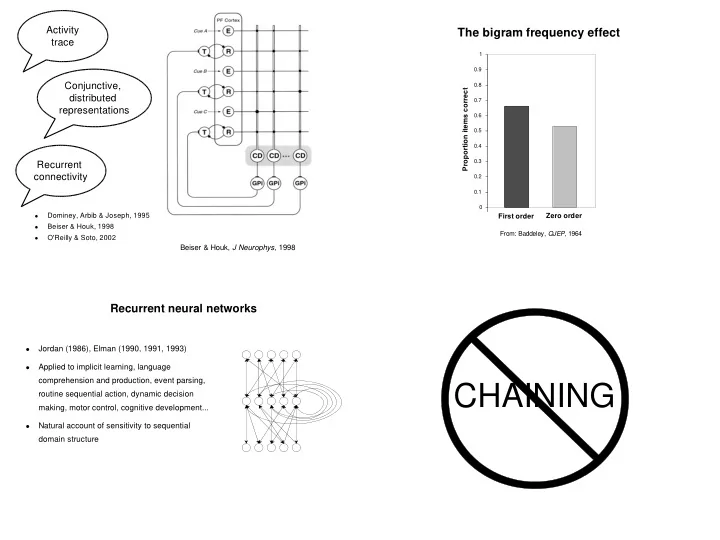

Activity The bigram frequency effect trace 1 0.9 Conjunctive, 0.8 Proportion items correct distributed 0.7 representations 0.6 0.5 0.4 0.3 Recurrent connectivity 0.2 0.1 0 • Dominey, Arbib & Joseph, 1995 Zero order First order • Beiser & Houk, 1998 From: Baddeley, QJEP , 1964 • O'Reilly & Soto, 2002 Beiser & Houk, J Neurophys, 1998 Recurrent neural networks • Jordan (1986), Elman (1990, 1991, 1993) • Applied to implicit learning, language comprehension and production, event parsing, CHAINING routine sequential action, dynamic decision making, motor control, cognitive development... • Natural account of sensitivity to sequential domain structure
The trouble with chaining Baddeley, QJEP , 1968 1 PC 0.9 • Initial interest PN 0.8 • AC Ebbinghaus 0.7 AN • Wickelgren (associative intrusions) 0.6 CHAINING Errors 0.5 • Murdock (TODAM) 0.4 • Eventual rejection 0.3 • Lashley 0.2 • Baddeley, 1968, sawtooth pattern 0.1 0 • Henson, Norris, Page & Baddeley, 1 2 3 4 5 6 1996: “Memory unchained” Position ??? Example AC list: B R D Q P L Context-association models of serial recall Model architecture a b c d … B T C V G Hebbian links List items (output) Context signal List items (input) a b c d … "Interactions between short- and • Burgess & Hitch, 1992 long-term memory pose problems • Henson, 1996 for most models of serial recall" • Houghton, 1990 (Henson, Cog. Psych. , 1998) • Brown, Preece & Hulme, 2000
Training and testing Data Simulation Same trial structure (encoding, recall) during training and testing � 1 Actual relevant “training” experience is from language 1 � 0.9 0.9 List lengths 1-9 � 0.8 0.8 0.7 0.7 Proportion Proportion Trained on small proportion of possible sequences (< 1 / 1,000) � 0.6 0.6 0.5 0.5 Training: backpropagation learning procedure � 0.4 0.4 0.3 0.3 Testing: weights frozen (during both encoding and recall) � 0.2 0.2 0.1 0.1 Three simulations � 0 0 1 2 3 4 5 6 1 2 3 4 5 6 1. Localist letter units Output position Output position 2. Two-dimensional items (confusable / non-confusable) 3. Bigram frequencies of English Empirical data: Henson, Norris, Page & Baddeley, QJEP , 1996 Transposition errors 1 0.9 0.8 0.7 0.6 Accuracy 0.5 0.4 0.3 0.2 0.1 0 4 5 6 7 8 9 10 11 List length Empirical data: Crannell & Parrish, J Psychol , 1957
Data Simulation Simulation Data 1 1 PC 0.9 0.9 1 1 PN 0.8 0.8 0.9 0.9 AC Errors (proportion) 0.8 0.8 0.7 0.7 AN 0.7 0.7 0.6 0.6 Accuracy 0.6 0.6 Accuracy 0.5 0.5 0.5 0.5 0.4 0.4 0.4 0.4 0.3 0.3 0.3 0.3 High BF 0.2 0.2 0.2 0.2 Low BF 0.1 0.1 0.1 0.1 0 0 0 0 1 2 3 4 5 6 7 8 9 1 2 3 4 5 6 7 8 9 1 2 3 4 5 6 1 2 3 4 5 6 Position Position Position Position Empirical data: Kantowitz, Ornstein & Schwartz, JEP , 1972 Empirical data: Baddeley, QJEP , 1968 Grouping effects 1 Empirical data Model 0.9 Proportion items correct 0.8 0.7 0.6 First order 0.5 Zero order 0.4 0.3 0.2 0.1 0 Data Simulation Empirical data: Baddeley, QJEP , 1964
Representational similarity T1 R2 B3 L4 B2 D2 D3 S2 S3 1.0 B3 items’ contributions ( r 2 ) 0.8 Similarity between D3 Correlation Similarity chart for isr Same item 0.6 Confusable Non-confusable B2 0.4 S3 D2 0.2 S2 T R B L . . . T R B L 0.0 0 1 2 3 Distance Distance between positions of contributing items
B4 6 5 5 5 Non-confusable Position from reference (Median) B3 Euclidean distance D3 S3 Euclidian distance 4 4 4 3 3 3 D2 F2 2 2 2 1 Confusable S1 F1 Non-confusable Confusable 0 2 4 6 8 10 12 14 16 18 Degree of re-ordering Cumulative transposition distance (Cumulative transposition distance) Item LRTFJ JFTRL LRFTJ ZDGBT ZDBGT Beiser & Houk, J Neurophys, 1998
Weight magnitudes The good neighbor effect : Assuming equal target goodness, recall accuracy will be lower for targets with high-goodness near neighbors (cf. consistency effects among “regular” words; Glushko, 1979; e.g., GAVE is slower than GATE due to interference from HAVE) Accuracy depends on: A 1 , A 2 , A 3 , B 1 , B 2 , B 3 1. Frequency (goodness) of target 2. Neighborhood relations of target a. Similar (near) neighbors: lower accuracy B A 0.75 b. High-frequency neighbors: lower accuracy 0.75 A B B A 0.25 0.25 (analogous to frequency and regularity/consistency effects in single word reading; Andrews, 1982; Taraban & McClelland, 1987)
List structure Probability The good neighbor effect: ABABAB BABABA .00402 An experimental test (Botvinick, submitted) ABABBA BABAAB .00209 ABAABA BABBAB .00209 • Six undergraduate participants • Immediate serial recall AABBAB BBAABA .00106 ABBAAB BAABBA .00106 • Items: Six pseudo-words (dah, fie, poe, noo, tee, kay) AABABB BBABAA .00106 • ABABAB grammar ABAABB BABBAA .00106 • Auditory presentation (100 words / min) ABBBAA BAAABB .00052 • Verbal and keyboard responding (repeats prevented) AABBBA BBAAAB .00052 • Eight training, seven testing sessions (250 lists / session) AAABBB BBBAAA .00026 Empirical data Simulation 0.7 AABBAB 0.7 0.6 0.6 Proportion correct Proportion correct 0.5 0.5 0.4 0.4 ABBAAB ABABAB 0.3 0.3 0.2 0.2 0.1 0.1 ABAABB 0 0 0.302 0.15 0.076 0.037 0.019 0.302 0.15 0.076 0.037 0.019 Stimulus probability Stimulus class probability Stimulus probability Stimulus class probability AABABB AABABB 0.54* AABABB 0.51* Others 0.46 Others 0.44
Conclusions • Theory • Activation-based coding, recurrent connectivity • Conjunctive representation of item, position • Sequence representation occupies continuous, multidimensional space • Graded similarity structure • Evidence • Fits with neuroanatomic, neurophysiologic data • Fits with behavioral data (this isn't chaining) • Exhibits appropriate sensitivity to domain structure
Recommend
More recommend